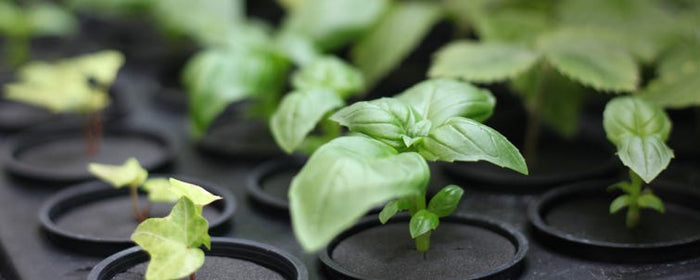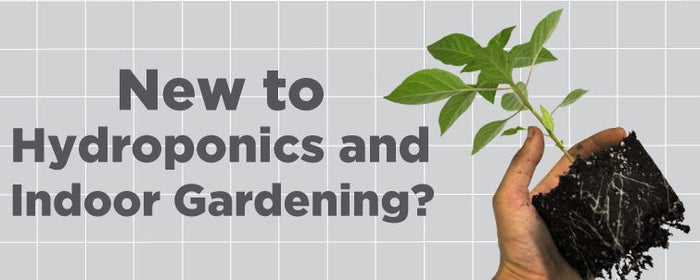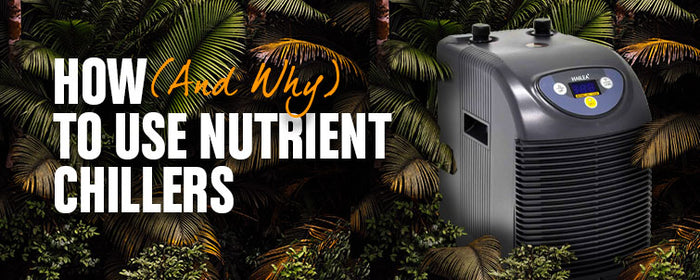
12 Ways To Survive Summer In Hydro
Keeping on top of your hydro system during summer can be a pain. Temperatures soar, humidity drops…but fear not! There are some easy ways to keep your plants happy and yields high.
Here are our top tips for growing in hydro during summer.

1. Chill Your Nutrient Solution
Your nutrient solution should be 18oC – 21oC. At this temperature, dissolved oxygen levels and overall growth are high.
A Hailea Nutrient Chiller is a quick and easy way of making sure you stay inside this range. It’s much harder to grow in summer without one.

2. Chill at the Right Point in Your System
As a rule, you want to chill the biggest body of water in your system.
In an NFT system it’s easy – you’ve got one tank – chill the feed in it.
In any system that dumps feed back to your tank, chill the feed in your tank. This is anyone that has a Flood & Drain or R-DWC Dumpback System.
If your system has one, chill at the brain unit. That’s the R-DWC (Recirculating Only) Systems.
3. Prevent Pythium
When temperatures climb, Pythium can quickly take hold.
To prevent this, use Silver Bullet Roots from the start of your grow.
Just a small dose eliminates 99.99% of root rot problems. To treat existing problems, use a shock dose of 8ml/10L.
4. Go High On The Oxygen
As your feed’s temperature rises, your dissolved oxygen level drops. With less oxygen, nutrient uptake slows and plants become vulnerable to root diseases.
When your nutrient solution’s warm and exposed to light, algae can quickly take hold. Once you’ve got algae, your oxygen level drops further.
If your feed’s temperature does climb above 21oC, add extra oxygen with more air stones. It’s also worth remembering that both Silver Bullet and Oxy-Plus 11.9% release oxygen when added to your system.

5. Top Up And Change Your Tank More Often

Plants drink more in summer. As plants drink more water, they often leave behind the nutrients, making the nutrient solution stronger.
If you’re not careful, you can overfeed plants…in extreme cases, you can get nutrient burn. In short, you need to keep your eye on your nutrient strength.
Keep your tank topped up with water to meet your target CF/EC, and change your tank more often.
6. Use The Right Nutrients And Additives
SHOGUN Silicon is great in summer. It helps plants better cope with heat and a low humidity. It’ll also great for warding off pests.
![]()
7. Make Sure Lights Don’t Warm Your Nutrient Solution

Black tanks and Oxypots absorb heat. Any solution in them will quickly get warmed by your grow lights.
To prevent this, cover your tank and Oxypots with reflective sheeting (white or silver side up). This reflects light and heat emitted by your grow light to stop it warming your feed.
If you haven’t already got it, think about using RhizoLine Pipe – it’ll reduce the temperature of the feed in your pipe work by 3oC – 8oC.
8. Change Your Lighting Layout
Your lighting systems are the biggest source of heat in your grow room. To control your temperature, focus on your lights.
If you don’t already, run lights at night, when it’s cooler. This means they can be off during the day when you’re more likely to get heat problems.
Next up, raise your lights by a few inches so there’s a bigger gap between plants and your lamp. If you can, keep your ballast outside your grow room.
It’s always a good idea to point an air circulator fan at lights to stop heat building up under your lamp. Better still, use a DiffuseAir to push the heat away from the area between the lights and the canopy.
If you have dimmable digital ballasts, consider dimming some or all of them down to reduce heat output. The Gavita Master Controller really comes into its own in summer – it’ll automatically dim your lights to meet your target temperature.
9. Extract More Air

If you have a fan speed controller, fans will speed up when your temperature rises. Just make sure your fan’s powerful enough to extract enough air. Some growers switch to a bigger fan in summer, then change back again in winter.
You won't go wrong with a Silenced Revolution Vector EC Fan. They extract more air silently and are cheaper to run. It's everything you could want in a fan.
Remember that your grow room can only be as cool as the outside air that you’re drawing in. You may need to fit an air conditioning system.
10. Circulate Air
Point clip on fans at your reflector, tent corners and ballasts to prevent hot microclimates forming.
To mix air and prevent hot spots forming around plants, use a DiffuseAir. There’s no risk of causing windburn – unlike with oscillating fans, the air stream from the DiffuseAir doesn’t point directly at your plants.

11. Add CO2

If you’re going closed loop, add more CO2 to help plants better cope with heat.
How does it help? With photosynthesis.
Photosynthesis is where plants use light + CO2 + water to create energy. If they have the light and water, but not enough CO2 they will become stressed.
On top of this, as the air temperature increases, plants stomata (pores on the leaves that take in CO2 and release water) start to close in an attempt to conserve water. When this happens, their ability to take in CO2 decreases.
By adding more CO2, plants can still take in enough CO2, even with the stomata partially closed, so photosynthesis can continue and stress is reduced.
The easiest way to add CO2 is with ExHale Bags. Just activate them, hang them, and leave them to it.
It’s worth remembering that if you’re extracting more air to keep temperatures down, it is not worth while adding more CO2 as you’ll just extract it straight out.
12. Watch Out For Bugs
To make sure you don’t draw any insects into your grow room, cover the inlet of your intake fan with Bug Blockers.
But really, no matter how careful you are, bugs can sneak in. To be safe, hang Sticky Insect Traps around your room so you can spot invaders early. Inspect plants every 5 days, using a magnifying glass.
It’s a good idea to hang 1 – 2 sachets of spider mite predators from each plant every 3 – 4 weeks too as spider mites are a common problem.






